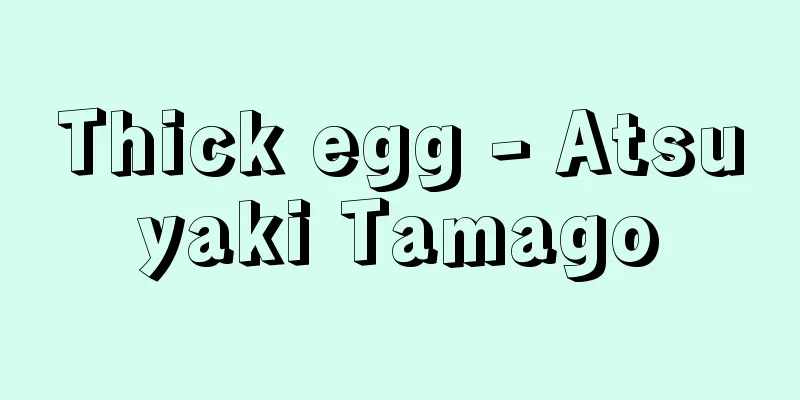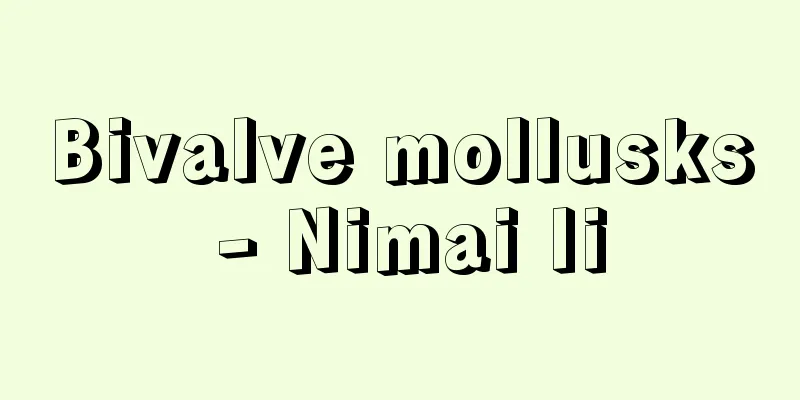Arch - Arch (English spelling)

|
A structure in which wedge-shaped bricks or stones are stacked along a curved line to create an opening that convex upwards, allowing it to support its own weight and the weight of the wall above it. Arches are classified according to the shape of their curved line. An example of a round arch is a semicircular arch, and an example of a pointed arch is a lancet arch, which is made up of two circular arcs. Here is a brief explanation of the mechanical principles that allow an opening with a fairly wide span (distance between supports) to be made without intermediate supports, compared to the size of a small wedge-shaped brick or stone. When weights of equal weight are hung from a cable at equal intervals, only tension acts on the cable, and the cable shape is determined according to the weight distribution. The total weight is balanced by the vertical component of the tensile support force at both ends. When the cable curve is turned in a vertical plane so that a curve symmetrical to the horizontal plane h-h' is obtained, and wedge-shaped bricks are piled up, the weight of the bricks is supported mainly by the mutual pushing force, in contrast to the cable, and the total weight is finally transferred and supported at both ends. However, in an arch that is too flat, not only a vertical component but also a relatively large horizontal component is required as the support force at both ends. The action of the wedge-shaped bricks of an arch to support their own weight and the weight of the wall directly above them in this way is called the arching action. In order for an arch to perform its arching action, a sufficiently rigid foundation or support is required. Arch action is also used today in arches made of composite wood or reinforced concrete. A single bar with an upwardly convex, curved surface not only acts as an arch against vertical loads, but also acts as a beam to resist inertial forces caused by earthquakes and other external forces. In addition, arch trusses, which are made by combining multiple steel members to form a curved surface as a whole, also exhibit arch action. These modern arches are used to create large spans of space without internal supports such as columns. By arranging multiple arches in parallel, crossing each other, or combining them with shell structures, various long-span structures with dynamic appearances have been created. [Tsuneyoshi Nakamura] historyThe history of the arch is long, and triangular arches were already used in the Neolithic period. Curved arches were first used in Mesopotamia around 4000 BC. In Egypt, triangular arches were used in tombs, and vaults in grain buildings. A vault is a series of arches that are connected from front to back, but they are structurally similar. In Greece, lintel-type structures are common, but arches were used in the gate of the agora of Priene in the 2nd century BC. Large and beautiful arches were built by the Etruscans, and the remains of the Perugia City Gate remain. The Etruscan arch technology was inherited by the Romans, who developed it into their most important form of expression and technology. Roman architecture, including aqueducts, arenas, and basilicas, is unthinkable without arches. Ancient Roman arches were mainly semicircular, and medieval Romanesque architecture also followed this style. On the other hand, horseshoe arches were preferred in Islamic architecture. Gothic architecture created a magnificent style with the new pointed arch and related structural systems. The ogee arch, which has an inflection point and was also favored in Islam, was introduced into late Gothic architecture, adding splendor. Furthermore, the semicircular arch was revived in the Renaissance and Baroque. In the 19th century, iron arch structures became a breakthrough, making it possible to construct buildings with large spans. [Shigetake Nagao] ©Shogakukan "> Main types of arches ©Shogakukan "> Arching Action Source: Shogakukan Encyclopedia Nipponica About Encyclopedia Nipponica Information | Legend |
|
上方に凸な平面曲線状の開口部をつくるために、その平面曲線に沿って楔(くさび)形のれんがや石を逐次積み上げ、その自重とその上部の壁体の重量を支持できるようにした構造物。アーチはその平面曲線の形状により分類される。ラウンド・アーチround archの例としては半円アーチ、尖頭(せんとう)アーチの例としては2個の円弧からなるランセット・アーチlancet archなどがある。 楔形の小さなれんがや石のサイズに比べて、かなり広いスパンspan(支点間の距離)の開口部を、中間の支持体なしにつくることができる力学的原理を簡単に説明しておこう。等しい重量の重りを等間隔でケーブルに吊(つ)り下げると、ケーブルには引張り力だけが作用し、重量分布に応じたケーブル形状が定まる。全重量は両端の引張り支持力の鉛直成分とつり合う。鉛直面内で水平面h―h′に関して、そのケーブル曲線と対称な曲線が得られるように転回し、楔形れんがを積み上げると、れんがの自重はケーブルとは逆に、主として相互に押し合う力だけによって支持され、最終的には全重量が両端に伝えられて支持される。しかしあまりにも扁平なアーチでは、両端の支持力として鉛直成分のみならず比較的大きな水平成分も必要となる。このようにしてアーチの楔状れんがが自重やその直上の壁体重量を支持する作用をアーチ作用という。アーチがアーチ作用を発揮できるためには、十分強剛な基礎または支持台が必要となる。 アーチ作用は、現代では合成木材や鉄筋コンクリート構造のアーチにおいても利用されている。上方に凸な平面曲線状の単一の棒材は、鉛直荷重に対するアーチ作用のみならず、地震による慣性力や、その他の外力に対しても梁(はり)作用によって抵抗する能力をもっている。このほかに、鋼部材を多数組み合わせて、全体として平面曲線状を呈するように構成したアーチ形トラスも、アーチ作用を示す。これらの現代のアーチは、内部に柱などの支持体のない広大なスパンの空間を実現するのに利用される。多数のアーチを並列したり、交差させたり、あるいはシェル構造などと組み合わせたりして、ダイナミックな外観の種々の大スパン構造物がつくられてきた。 [中村恒善] 歴史アーチの歴史は古く、新石器時代にすでに三角形アーチが用いられた。曲線のアーチが最初に用いられたのは紀元前4000年ごろメソポタミアにおいてであった。エジプトでは墳墓で三角形アーチが、穀物舎でボールトvaultが採用された。アーチを前後に連続させたものをボールトというが構造的には同様のものである。ギリシアでは楣(まぐさ)式構造が一般的であるが、前2世紀になってプリエネのアゴラの門にアーチが使われた。大規模で美しいアーチはエトルリア人によって建設され、ペルージア市門の遺構がある。エトルリア人のアーチの技術はローマ人が受け継ぎ、彼らはそれをもっとも重要な造形表現、技術として展開していった。水道橋、闘技場、バシリカをはじめとして、ローマ建築はアーチを抜きにしては考えられないほどである。古代ローマのアーチはもっぱら半円形を主体とするもので、中世ロマネスク建築もこれを踏襲している。一方、イスラム建築では馬蹄(ばてい)形アーチhorseshoe archが好まれた。ゴシック建築は新しく尖頭(せんとう)アーチとこれに関連した架構システムによってみごとな様式をつくりあげた。イスラムでも好んで用いられた反曲点をもつオジー・アーチogee archが後期ゴシック建築に導入されて華やかさを加えた。さらにルネサンス、バロックでは半円アーチが復活した。19世紀になって鉄によるアーチ構造は大スパンの建造物の架構を可能にした画期的なものとなった。 [長尾重武] ©Shogakukan"> アーチのおもな種類 ©Shogakukan"> アーチ作用 出典 小学館 日本大百科全書(ニッポニカ)日本大百科全書(ニッポニカ)について 情報 | 凡例 |
<<: Aceh Province (English spelling)
Recommend
Sorority
…Connections such as academic cliques and local p...
Currency Hedge - KAWASEHEDGE
<br /> A method used to reduce exchange rate...
fuel oil
…It can also refer to heavy oil obtained by disti...
Burton, I.
... However, with the introduction of the metric ...
Communication channel - tsuushinro (English spelling) channel
A path through which information is transmitted. I...
Dream of the Red Chamber
A long vernacular (colloquial) novel from the Qia...
Mussels (English spelling: moule [France])
Mytilus edulis galloprovincialis , a Mediterranean...
Ulászló II (English spelling)
…The Jagiellonian dynasty's advance into Cent...
Remote Area Education
Generally speaking, a remote area is a remote reg...
Ono - Ono
[1] 〘 noun 〙 ("o" is a prefix) field. pl...
sonata da chiesa (English spelling) sonata dachiesa
…This was written primarily for the church and th...
Engineering method - Kouteisahou (English name)
An official architectural technique book compiled ...
Manchester (English spelling)
Manchester is the central city of the Greater Manc...
Allegory - Guuyu
Allegory is a literary work or a visual arts work...
Ami - Ami (English spelling) mysid
A general term for small aquatic animals belongin...









